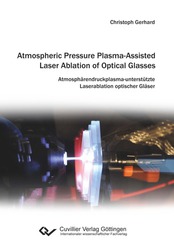| Departments | |
|---|---|
| Book Series (96) |
1379
|
| Nachhaltigkeit |
3
|
| Gesundheitswesen |
1
|
| Humanities |
2367
|
| Natural Sciences |
5407
|
| Mathematics | 229 |
| Informatics | 319 |
| Physics | 980 |
| Chemistry | 1364 |
| Geosciences | 131 |
| Human medicine | 243 |
| Stomatology | 10 |
| Veterinary medicine | 108 |
| Pharmacy | 147 |
| Biology | 835 |
| Biochemistry, molecular biology, gene technology | 121 |
| Biophysics | 25 |
| Domestic and nutritional science | 45 |
| Agricultural science | 1004 |
| Forest science | 201 |
| Horticultural science | 20 |
| Environmental research, ecology and landscape conservation | 148 |
| Engineering |
1793
|
| Common |
98
|
|
Leitlinien Unfallchirurgie
5. Auflage bestellen |
|
Advanced Search
Atmospheric Pressure Plasma-Assisted Laser Ablation of Optical Glasses (English shop)
Atmosphärendruckplasma-unterstützte Laserablation optischer Gläser
Christoph Gerhard (Author)Preview
Preface, PDF (43 KB)
Table of Contents, PDF (43 KB)
Extract, PDF (180 KB)
In the present work, two different approaches for atmospheric pressure plasma-assisted ablation of optical glasses were investigated. For sequential plasma-assisted ablation, the glasses were plasma pre-treated prior to laser ablation. Here, a hydrogenous process gas was applied in order to initiate a plasma-chemical surface modification. It was shown that relevant optical properties and in particular the transmission characteristics of the investigated glasses were modified as a result of such pre-treatment. Several underlying mechanisms were determined: (i) the formation of suboxide layers close to the glass surface, (ii) the implantation of hydrogen into deeper regions of the glass bulk material and (iii) surface roughening due to the plasma pre-treatment. As a result, an enhanced coupling of incoming laser irradiation during subsequent ablation was achieved. This effect allowed a significant reduction of the laser ablation threshold as well as an improved machining quality, i.e. a higher contour accuracy and a reduced surface roughness of the ablated area.
For simultaneous plasma-assisted ablation, the laser beam was guided coaxially to an argon plasma beam in order to benefit from plasmaphysical interactions. Due to an additional energy transfer by the plasma during ablation, the ablation rate was notably increased. It was further shown that the plasma beam used for this simultaneous process effects the smoothing of rough optical glass surfaces.
The combination of the investigated approaches thus allows providing a novel integrated plasma-assisted ablation process for the micro structuring of optical devices of high quality.
| ISBN-13 (Hard Copy) | 9783954048267 |
| ISBN-13 (eBook) | 9783736948266 |
| Final Book Format | A5 |
| Language | English |
| Page Number | 134 |
| Lamination of Cover | matt |
| Edition | 1 Aufl. |
| Publication Place | Göttingen |
| Place of Dissertation | Clausthal |
| Publication Date | 2014-10-16 |
| General Categorization | Dissertation |
| Departments |
Physics
Mechanical and process engineering |
| Keywords | atmospheric pressure plasmas, optical glasses, hybrid laser ablation, Atmosphärendruckplasmen, optische Gläser, Hybrid-Laserablation |








